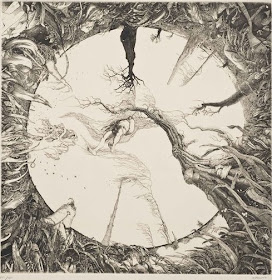Along with Gérard Trignac and Érik Desmazières, Mohlitz is part of the French "Fantastic Art" movement. L'art fantastique draws on the European surrealist tradition, and on symbolists like Odilon Redon and Rodolphe Bresdin. But it developed in new directions through involvement with the classic science fiction of the 1960s. I confess that I used to have rather stereotyped views of France, and I was startled to discovered that there is a whole subculture of French techies who reject French intellectual life and admire American and British science fiction, from Ray Bradbury to Star Trek and Star Wars.
Mohlitz has a strong post-apocalyptic theme in his art. He loves ruins and shacks thrown together from flotsam. Which makes it surprising to me that he is not more popular in North America these days.
Mohlitz is far from a happy artist:
His bizarre images of decay, war, and weird deserted lands are drawn from the realms of science fantasy, whilst following firmly in the Surrealist tradition. Rich in detail, his images of strange aviators aboard weird flying machines, balloons, ships, tanks and warfare, set in impossible landscapes, are filled with a pervasive sense of the macabre. Death haunts these visions and nightmares in their peripheral details of gruesome sexual content and morbid eroticism. The grotesque decaying corpses of buildings, machines and people, often overgrown with vegetation, fill these inspired works with horror and macabre delight.The Minister of Health, another large, detailed image.
The Golden Age, 1966.
Archeologie, 1986
L'atelier, 1989
December 31, 1982
Heros Attacked by 36 People
Modern Times, 1972













No comments:
Post a Comment